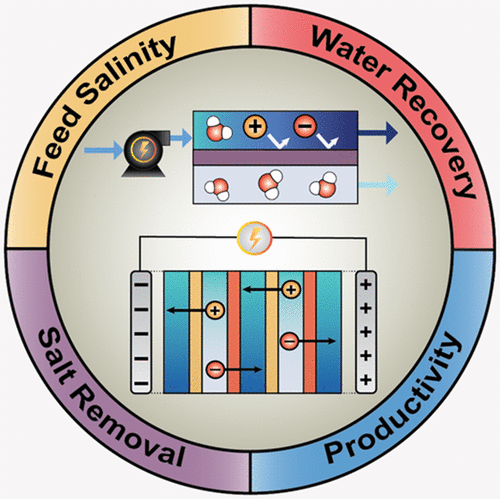当前位置:
X-MOL 学术
›
ACS ES&T Eng.
›
论文详情
Our official English website, www.x-mol.net, welcomes your
feedback! (Note: you will need to create a separate account there.)
Energy Consumption of Brackish Water Desalination: Identifying the Sweet Spots for Electrodialysis and Reverse Osmosis
ACS ES&T Engineering ( IF 7.4 ) Pub Date : 2021-01-22 , DOI: 10.1021/acsestengg.0c00192 Sohum K. Patel 1, 2 , P. Maarten Biesheuvel 3 , Menachem Elimelech 1, 2
ACS ES&T Engineering ( IF 7.4 ) Pub Date : 2021-01-22 , DOI: 10.1021/acsestengg.0c00192 Sohum K. Patel 1, 2 , P. Maarten Biesheuvel 3 , Menachem Elimelech 1, 2
Affiliation

|
Though electrodialysis (ED) and reverse osmosis (RO) are both mature, proven technologies for brackish water desalination, RO is currently utilized to desalinate over an order of magnitude more brackish water than ED. This large discrepancy in the adoption of each technology has yet to be thoroughly justified in the literature, particularly from the perspective of energy consumption. Hence, in this study, we performed a direct and systematic comparison of the energy consumption of RO and ED for brackish water desalination, precisely mapping out the ideal operational space of each technology for the first time. Using rigorous system-scale models for RO and ED, we determine the specific energy consumption and energy efficiency of each process over a wide range of brackish water conditions. Specifically, we investigate the effects of varying feed salinity, extent of salt removal, water recovery, and productivity to ultimately identify the operational sweet spots of each technology. By maintaining the same separation parameters (i.e., feed salinity, salt removal, water recovery) and productivity between RO and ED throughout the study, we ensure that our comparison of the technologies is valid and fair. Our results indicate that both RO and ED are capable of operating with high energy efficiency (>30%) for brackish water desalination, though for differing conditions. Particularly, we show that whereas ED excels for low feed salinities (<3 g L–1) and extents of salt removal, RO operates optimally for high salinity feeds (>5 g L–1), which require more extensive desalination. Through our in-depth energetic analysis, we provide guidance for future applications of RO and ED, emphasizing that increased implementation of ED will require significant reduction in the cost of ion-exchange membranes.
中文翻译:

淡盐水淡化的能量消耗:确定电渗析和反渗透的最佳位置
尽管电渗析(ED)和反渗透(RO)都是成熟的,经过验证的微咸水淡化技术,但RO目前用于淡化微咸水的量比ED多。每种技术的采用之间的巨大差异在文献中还没有得到充分论证,特别是从能源消耗的角度来看。因此,在这项研究中,我们对咸水淡化用RO和ED的能耗进行了直接而系统的比较,首次精确地绘制出每种技术的理想操作空间。使用针对RO和ED的严格的系统规模模型,我们可以确定各种咸水条件下每个过程的比能耗和能效。具体来说,我们研究了不同盐度,盐分去除程度,水回收率和生产率的影响,以最终确定每种技术的有效结合点。在整个研究过程中,通过在反渗透和ED之间保持相同的分离参数(即饲料盐度,除盐,水回收率)和生产率,我们确保我们对技术的比较是有效和公平的。我们的结果表明,尽管条件不同,但RO和ED都能够以高能效(> 30%)进行微咸水淡化。特别是,我们表明ED在低盐度(<3 g L 在整个研究过程中,RO和ED之间的盐去除,水回收率和生产率),我们确保我们对技术的比较是有效和公平的。我们的结果表明,尽管条件不同,但RO和ED都能够以高能效(> 30%)进行微咸水淡化。特别是,我们表明ED在低盐度(<3 g L 在整个研究过程中,RO和ED之间的盐去除,水回收率和生产率),我们确保我们对技术的比较是有效和公平的。我们的结果表明,尽管条件不同,但RO和ED都能够以高能效(> 30%)进行微咸水淡化。特别是,我们表明ED在低盐度(<3 g L–1)和除盐程度,RO对于高盐度饲料(> 5 g L –1)需要最佳的操作,这需要更广泛的脱盐。通过深入的能量分析,我们为RO和ED的未来应用提供了指导,并强调增加ED的实施将需要大幅降低离子交换膜的成本。
更新日期:2021-01-22
中文翻译:

淡盐水淡化的能量消耗:确定电渗析和反渗透的最佳位置
尽管电渗析(ED)和反渗透(RO)都是成熟的,经过验证的微咸水淡化技术,但RO目前用于淡化微咸水的量比ED多。每种技术的采用之间的巨大差异在文献中还没有得到充分论证,特别是从能源消耗的角度来看。因此,在这项研究中,我们对咸水淡化用RO和ED的能耗进行了直接而系统的比较,首次精确地绘制出每种技术的理想操作空间。使用针对RO和ED的严格的系统规模模型,我们可以确定各种咸水条件下每个过程的比能耗和能效。具体来说,我们研究了不同盐度,盐分去除程度,水回收率和生产率的影响,以最终确定每种技术的有效结合点。在整个研究过程中,通过在反渗透和ED之间保持相同的分离参数(即饲料盐度,除盐,水回收率)和生产率,我们确保我们对技术的比较是有效和公平的。我们的结果表明,尽管条件不同,但RO和ED都能够以高能效(> 30%)进行微咸水淡化。特别是,我们表明ED在低盐度(<3 g L 在整个研究过程中,RO和ED之间的盐去除,水回收率和生产率),我们确保我们对技术的比较是有效和公平的。我们的结果表明,尽管条件不同,但RO和ED都能够以高能效(> 30%)进行微咸水淡化。特别是,我们表明ED在低盐度(<3 g L 在整个研究过程中,RO和ED之间的盐去除,水回收率和生产率),我们确保我们对技术的比较是有效和公平的。我们的结果表明,尽管条件不同,但RO和ED都能够以高能效(> 30%)进行微咸水淡化。特别是,我们表明ED在低盐度(<3 g L–1)和除盐程度,RO对于高盐度饲料(> 5 g L –1)需要最佳的操作,这需要更广泛的脱盐。通过深入的能量分析,我们为RO和ED的未来应用提供了指导,并强调增加ED的实施将需要大幅降低离子交换膜的成本。











































 京公网安备 11010802027423号
京公网安备 11010802027423号